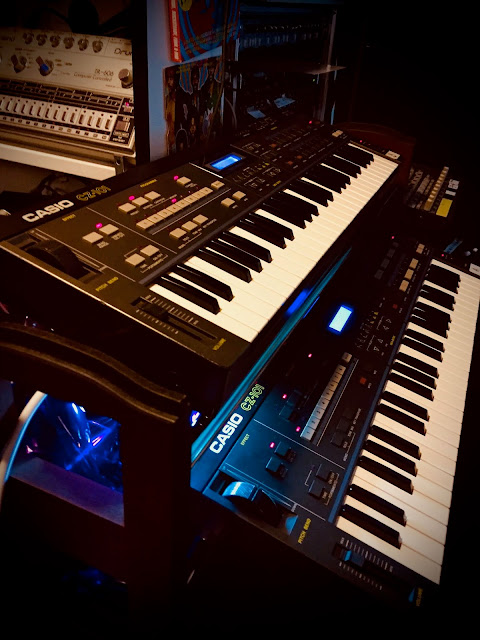Racking my two CZ-101 s together and using one as master and the other as slave, gave rise to some previously unnoticed creative possibilities. And since the whole is now more than the sum of its parts, it needs a new name: how about CZ-202?
Plugging them into a stereo channel so that each synth occupies one channel exclusively, and then detuning them in opposite directions from the dedicated front panel buttons, gives a huge stereo effect. Powerful basses, rich moving strings, lively percussion. Again from the front panel, you can quickly transpose and set individual bend ranges in discrete semitones, for one finger intervals that move with the bender. Moving the master bender bends both synths, the slave bender just one. Playing the master keys but using the slave bender - the results can either be very ravey or almost Nashville-style pedal steel guitar, depending on the voices and intervals. All of this takes under a minute thanks to the design of the interface.
The CZ range of synths was introduced in 1984. They were probably the most affordable polyphonic synthesisers to date. But they had limitations that have garnered them a bit of bad press from some corners. The sound parameters, and that includes the filters, can't be modified in real time. And all, except for the last in the line, the CZ-1, lack velocity and aftertouch.
Their versatility and expressiveness can be improved with the application of a little of what I call 'midi-bending'. Like its counterpart 'circuit-bending', here we put midi functions to use in ways slightly different from their design intention. For this you will need a capable midi sequencer.
For example, velocity sensitivity can be 'faked' using midi Mono Mode. The CZ range allows 4 voice multitimbral response in Mono Mode, i.e. a monophonic voice per channel, for four adjacent midi channels, set from the dedicated Midi button. The four voices are freely assignable. Say you have a resonant bass patch: copy it four times to different internal memory locations, and then edit, say, the filter or amp response in each patch to give different "velocities". Trigger these four patches from 4 channels of the sequencer, and the bass sound gains a whole new dimension of expression. While it seems that PB (pitchbend) messages aren't received on all mono channels, portamento messages (CC#65 porta on/off, and CC#5 porta time) are recognised, allowing slides. While you can't slide 'between channels' it can be mimicked with a bit of experimenting, using duplicate notes. CZ acieed!
For example, velocity sensitivity can be 'faked' using midi Mono Mode. The CZ range allows 4 voice multitimbral response in Mono Mode, i.e. a monophonic voice per channel, for four adjacent midi channels, set from the dedicated Midi button. The four voices are freely assignable. Say you have a resonant bass patch: copy it four times to different internal memory locations, and then edit, say, the filter or amp response in each patch to give different "velocities". Trigger these four patches from 4 channels of the sequencer, and the bass sound gains a whole new dimension of expression. While it seems that PB (pitchbend) messages aren't received on all mono channels, portamento messages (CC#65 porta on/off, and CC#5 porta time) are recognised, allowing slides. While you can't slide 'between channels' it can be mimicked with a bit of experimenting, using duplicate notes. CZ acieed!
Sequencing several PG (program change) messages within a midi phrase can do something similar, without requiring Mono Mode, giving you full polyphony. But PG sequencing has got some great use in generating new riffs or ideas as well. Try syncopating them with the rhythm of the track, while playing a run of 8th or 16th notes. This always leads to unexpected but often useful results, depending on the voices selected. Fast attack sounds can lead to melodic percussion lines, slower envelopes can produce rhythmic ambient textures. You may need to tweak the actual timing of the PG messages, pulling them a few milliseconds ahead of the required note, to allow time for the machine to respond. If the results are not inspiring, change one or two of those PG numbers. This often leads to a whole new riff/feel. The midi phrase doesn't have to be so rigid of course. Program the PG sequence first then simply jam over the top.
Note, when you're throwing this much midi at the CZ, the 1984-era midi buffer might choke, causing all sorts of weirdness. Each channel can be sent a couple of unobtrusively-placed PG messages (change the voice to something then change it back) to re-set it on the fly when this occurs.



Comments
Post a Comment